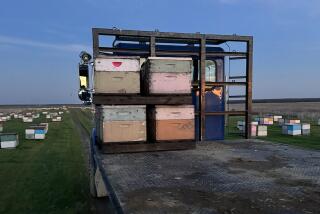Information Is the Best Defense Against Africanized Honeybees Help Line
- Share via
Question: I heard that “killer bees” have become a menace in Orange County. What should I do to protect my family?
C.R., Fountain Valley
Answer: What many people call killer bees are Africanized honeybees. They were first sighted in Orange County in March 1999. While they can be dangerous, they aren’t a menace. Fear of these bees should not prevent you from gardening or enjoying other outdoor activities.
According to Nick Nisson, the Orange County entomologist with the California State Agricultural Commission, emergency services report serious bee stinging incidents to the Agricultural Commission. Thus far, not one has been reported in Orange County.
In fact, since the Africanized bees migrated across the Mexican border into the United States in 1990, fewer than 10 deaths have been attributed to them. So the risk of a serious bee attack is similar to the risk of being attacked by a bear, a shark or a mountain lion.
Your best course of action is to learn about the habits of these bees and take precautions. Until the arrival of the Africanized variety, the bee commonly encountered in Orange County was the domesticated European honeybee, which was bred for gentleness and honey production.
The European bee also plays an important role in pollinating garden plants and commercial crops.
Africanized bees were introduced to South America during the 1950s in the hope they would adopt more readily than European bees to tropical climates in the Americas. Unfortunately, Africanized bees are wild by nature, more easily upset than European bees and do not take to domestication.
Nevertheless, in many ways they resemble European bees--they can be distinguished by appearance only in the laboratory.
Although there are important differences in the behaviors of Africanized and European bees, they are similar in many ways. An understanding of the habits common to both bees, and the habits unique to Africanized bees, will help prevent stinging by either type of bee.
When bees are gathering pollen or nectar, they do not have time to bother people. There is little risk of being stung by these bees unless they are trapped or harmed.
Bees are often attracted to evaporative water coolers or to standing water in pets’ dishes, birdbaths or ponds, and may be attracted in large numbers. These bees, like foraging bees, are not likely to be aggressive unless harmed.
Scent attracts bees, though, so if you do not want the close companionship of curious bees, avoid floral or citrus after shave and perfume. The company of bees may also be discouraged by wearing light-colored clothing in the garden and on outings. Bees are more likely to attack dark clothing, dark hair and dark skin.
In the spring and sometimes in the fall, it is normal for one-half of the work force of a bee colony and a queen to separate from the mother colony and fly out (swarm) to search for a new home. Both Africanized and European bees engage in this activity, although Africanized bees swarm more frequently.
Since they have no young bees to protect, swarming bees of both types tend to be mild-mannered and are not likely to be a threat unless they are molested by rock-throwing or similar activity. Usually a swarm will move on in a day or two.
Once bees establish colonies, they will defend them. The difference between the two types of bees is that the Africanized variety defends a larger area around nests, pursues intruders sooner and in larger numbers, and carries the chase farther.
Africanized bees may feel threatened by people 50 feet or more from their nests and are sensitive to the vibrations of power equipment 100 feet or more from their nests. Serious stinging incidents often arise from the use of power equipment, such as mowers, weed-eaters, or chain-saws near their colonies.
European bees that become agitated will pursue an intruder as far as the length of one-half of a football field. Africanized bees will continue the pursuit even farther, for one-quarter mile or more.
As with European bees, each Africanized bee can sting only once. The sting of an Africanized bee is no more potent than that of the European bee, but its aggressiveness, persistence and the number of bees that join in attacks makes then more dangerous.
*
Written and researched by University of California master gardener in-training Harold Pope of Irvine.
*
University of California Cooperative Extension (UCCE) Master Gardeners are here to help. These trained and certified horticultural volunteers are dedicated to extending research-based, scientifically accurate information to the public about home horticulture and pest management. They are involved with a variety of outreach programs, including the UCCE Master Garden hotline, which provides answers to specific questions. You can reach the hotline at (714) 708-1646 or send e-mail to ucmastergardeners @yahoo.com. Calls and e-mail are picked up daily and are generally returned within three days.
*
Next Week
* Avoid unpleasant encounters with Africanized honeybees by preventing the establishment of colonies near your house or garden.
(BEGIN TEXT OF INFOBOX / INFOGRAPHIC)
Beeware
European and Africanized honeybees closely resemble each other (Africanized are slightly smaller.) Both can produce honey and wax, sting only once and have the same venom. Behavioral differences are more noticeable. Africanized bees (“killer bees”) respond quickly in defense and sting in large numbers.
European honeybee (Apis mellifera)
Africanized honeybee (Apis mellifera scupellata)
Bumblebee (Bombus species)
Source: University of California.


